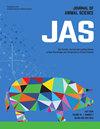18个美国牛品种生长和胴体性状的品种特异性杂种优势
IF 2.7
2区 农林科学
Q1 AGRICULTURE, DAIRY & ANIMAL SCIENCE
引用次数: 0
摘要
杂种优势,或杂种优势,传统上被定义为杂交后代相对于其纯种父母的平均表现的优势。这种优势是由于这些杂交的杂合性增加,这增加了受非加性基因作用影响的性状的表型表达。这些杂种优势效应可能因原杂交中动物的品种而异;然而,由于缺乏杂交牛和纯种牛之间的当代比较,难以获得特定品种的估计。美国肉类动物研究中心的种质评估项目旨在评估美国18种利用率最高的牛肉品种,并对纯种牛及其杂交品种进行当代比较。因此,本研究的主要目的是量化这18个美国牛肉品种在生长和胴体性状方面的品种特异性杂种优势差异。具体性状分析为直接和母本出生体重、直接和母本205d调整断奶体重、365d断奶后增重、大理石纹评分、肋眼面积、背膘厚度和胴体重。使用两种不同的模型来估计特定的杂种优势效应:1)一个生物群体杂种优势模型,其中估计英国、大陆和婆罗门作为品种群体之间杂交的杂种优势;2)一个平均品种杂种优势模型,其中杂种优势是通过对18个品种中的每一个品种与群体中随机选择的动物交配产生的平均预测品种杂合度的回归来估计的。每个模型还包括每对品种的随机品种特异性交叉效应。在所有性状中都发现了生物群杂种优势,或在英国群、婆罗门群和大陆群的所有杂交中预期的纯种均数偏差(P <;0.0001),大理石花纹除外。估计含有婆罗门的杂交对犊牛生产性能的提高最大,特别是在生长性状和母畜能力方面。平均品种特异性杂种优势也显著(P <;除大理石纹和产妇出生体重外,其他性状均低于第二模型。在大多数性状中,犊牛生产性能的最大提高被发现是与婆罗门杂交的结果。育种者可以利用这些估计来做出更明智的杂交决策,并根据其特定的生产环境和育种目标来调整品种选择。本文章由计算机程序翻译,如有差异,请以英文原文为准。
Breed-specific heterosis for growth and carcass traits in 18 U.S. cattle breeds
Heterosis, or hybrid vigor, is traditionally defined as the advantage of crossbred progeny relative to the average performance of their purebred parents. This advantage is due to increased heterozygosity in these crosses, which increases phenotypic expression in traits influenced by non-additive gene action. These heterosis effects may vary depending on the breed of animals in the original cross; however, breed-specific estimates are difficult to obtain because of a lack of contemporary comparisons among crossbred and purebred cattle. The Germplasm Evaluation Program at the U.S. Meat Animal Research Center was designed to evaluate 18 of the most highly utilized beef breeds in the United States and enable contemporary comparisons among purebreds and their crosses. Therefore, the primary objective of this study was to quantify the differences in breed-specific heterosis for growth and carcass traits in these 18 U.S. beef breeds. Specific traits analyzed were direct and maternal birth weight, direct and maternal 205d adjusted weaning weight, 365d postweaning gain, marbling score, ribeye area, backfat thickness, and carcass weight. Specific heterosis effects were estimated using two different models: 1) a biological-group heterosis model where heterosis was estimated for crosses between British, Continental, and Brahman as breed groups, and 2) an average breed heterosis model where heterosis was estimated as the regression on average predicted breed heterozygosity arising from mating each of the 18 breeds to a randomly chosen animal in the population. Each model also included a random breed-specific cross effect for each pair of breeds. Biological-group heterosis, or the expected deviations from a purebred mean between all crosses of British-, Brahman-, and Continental-groups, was found for all traits (P < 0.0001), except marbling. The greatest increases in calf performance were estimated for crosses containing Brahman, especially for growth traits and maternal ability. Average breed-specific heterosis was also significant (P < 0.05) under the second model again for all traits except marbling and maternal birth weight. Again, the greatest increase in calf performance across a majority of traits was found to be the result of crosses with Brahman. These estimates may be used by breeders to make more informed crossbreeding decisions, and to tailor their choice of breeds to their specific production environment and breeding objectives.
求助全文
通过发布文献求助,成功后即可免费获取论文全文。
去求助
来源期刊

Journal of animal science
农林科学-奶制品与动物科学
CiteScore
4.80
自引率
12.10%
发文量
1589
审稿时长
3 months
期刊介绍:
The Journal of Animal Science (JAS) is the premier journal for animal science and serves as the leading source of new knowledge and perspective in this area. JAS publishes more than 500 fully reviewed research articles, invited reviews, technical notes, and letters to the editor each year.
Articles published in JAS encompass a broad range of research topics in animal production and fundamental aspects of genetics, nutrition, physiology, and preparation and utilization of animal products. Articles typically report research with beef cattle, companion animals, goats, horses, pigs, and sheep; however, studies involving other farm animals, aquatic and wildlife species, and laboratory animal species that address fundamental questions related to livestock and companion animal biology will be considered for publication.
 求助内容:
求助内容: 应助结果提醒方式:
应助结果提醒方式:


